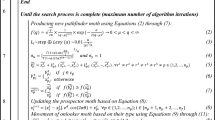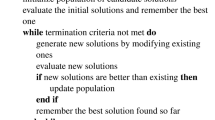Abstract
This paper proposes a multi-objective version of the recently proposed Ant Lion Optimizer (ALO) called Multi-Objective Ant Lion Optimizer (MOALO). A repository is first employed to store non-dominated Pareto optimal solutions obtained so far. Solutions are then chosen from this repository using a roulette wheel mechanism based on the coverage of solutions as antlions to guide ants towards promising regions of multi-objective search spaces. To prove the effectiveness of the algorithm proposed, a set of standard unconstrained and constrained test functions is employed. Also, the algorithm is applied to a variety of multi-objective engineering design problems: cantilever beam design, brushless dc wheel motor design, disk brake design, 4-bar truss design, safety isolating transformer design, speed reduced design, and welded beam deign. The results are verified by comparing MOALO against NSGA-II and MOPSO. The results of the proposed algorithm on the test functions show that this algorithm benefits from high convergence and coverage. The results of the algorithm on the engineering design problems demonstrate its applicability is solving challenging real-world problems as well.





Similar content being viewed by others
References
Kelley CT (1999) Detection and remediation of stagnation in the Nelder–Mead algorithm using a sufficient decrease condition. SIAM J Optim 10:43–55
Vogl TP, Mangis J, Rigler A, Zink W, Alkon D (1988) Accelerating the convergence of the back-propagation method. Biol Cybern 59:257–263
Marler RT, Arora JS (2004) Survey of multi-objective optimization methods for engineering. Struct Multidiscip Optim 26:369–395
Coello CAC (2002) Theoretical and numerical constraint-handling techniques used with evolutionary algorithms: a survey of the state of the art. Comput Methods Appl Mech Eng 191:1245–1287
Beyer H.-G., Sendhoff B (2007) Robust optimization–a comprehensive survey. Comput Methods Appl Mech Eng 196:3190–3218
Knowles JD, Watson RA, Corne DW (2001) Reducing local optima in single-objective problems by multi-objectivization. In: Evolutionary multi-criterion optimization, pp 269–283
Deb K, Goldberg DE (1993) Analyzing deception in trap functions. Found Genet Algoritm 2:93–108
Deb K (2001) Multi-objective optimization using evolutionary algorithms, vol 16. Wiley
Coello CAC, Lamont GB, Van Veldhuisen DA (2007) Evolutionary algorithms for solving multi-objective problems. Springer
Branke J, Deb K, Dierolf H, Osswald M (2004) Finding knees in multi-objective optimization. In: Parallel problem solving from nature-PPSN VIII, pp 722–731
Das I, Dennis JE (1998) Normal-boundary intersection: a new method for generating the Pareto surface in nonlinear multicriteria optimization problems. SIAM J Optim 8:631–657
Kim IY, De Weck O (2005) Adaptive weighted-sum method for bi-objective optimization: Pareto front generation. Struct Multidiscip Optim 29:149–158
Messac A, Mattson CA (2002) Generating well-distributed sets of Pareto points for engineering design using physical programming. Optim Eng 3:431–450
Deb K, Agrawal S, Pratap A, Meyarivan T (2000) A fast elitist non-dominated sorting genetic algorithm for multi-objective optimization: NSGA-II. In: Parallel problem solving from nature PPSN VI, pp 849–858
Deb K, Goel T (2001) Controlled elitist non-dominated sorting genetic algorithms for better convergence. In: Evolutionary multi-criterion optimization, pp 67–81
Deb K, Pratap A, Agarwal S, Meyarivan T (2002) A fast and elitist multiobjective genetic algorithm: NSGA-II. IEEE Trans Evol Comput 6:182–197
Coello CAC, Lechuga MS (2002) MOPSO: a proposal for multiple objective particle swarm optimization. In: Proceedings of the 2002 congress on evolutionary computation, 2002. CEC’02, pp 1051–1056
Coello CAC, Pulido GT, Lechuga MS (2004) Handling multiple objectives with particle swarm optimization. IEEE Trans Evol Comput 8:256–279
Akbari R, Hedayatzadeh R, Ziarati K, Hassanizadeh B (2012) A multi-objective artificial bee colony algorithm. Swarm Evol Comput 2:39–52
Yang X-S (2011) Bat algorithm for multi-objective optimisation. Int J Bio-Inspired Comput 3:267–274
Mirjalili S, Saremi S, Mirjalili SM, Coelho L. d. S. (2016) Multi-objective grey wolf optimizer: a novel algorithm for multi-criterion optimization. Expert Syst Appl 47:106–119
Wolpert DH, Macready WG (1997) No free lunch theorems for optimization. IEEE Trans Evol Comput 1:67–82
Ngatchou P, Zarei A, El-Sharkawi M (2005) Pareto multi objective optimization. In: Proceedings of the 13th international conference on intelligent systems application to power systems, 2005, pp 84–91
Pareto V (1964) Cours d’economie politique: Librairie Droz
Edgeworth FY (1881) Mathematical physics. P. Keagan, London
Zitzler E (1999) Evolutionary algorithms for multiobjective optimization: methods and applications, vol 63. Citeseer
Zitzler E, Thiele L (1999) Multiobjective evolutionary algorithms: a comparative case study and the strength pareto approach. IEEE Trans Evol Comput 3:257–271
Srinivas N, Deb K (1994) Muiltiobjective optimization using nondominated sorting in genetic algorithms. Evol Comput 2:221–248
Zhang Q, Li H (2007) MOEA/D: a multiobjective evolutionary algorithm based on decomposition. IEEE Trans Evol Comput 11:712–731
Knowles JD, Corne DW (2000) Approximating the nondominated front using the Pareto archived evolution strategy. Evol Comput 8:149–172
Abbass HA, Sarker R, Newton C (2001) PDE: a Pareto-frontier differential evolution approach for multi-objective optimization problems. In: Proceedings of the 2001 congress on evolutionary computation, 2001, pp 971–978
Branke J, Kaußler T, Schmeck H (2001) Guidance in evolutionary multi-objective optimization. Adv Eng Softw 32:499– 507
Eberhart RC, Kennedy J (1995) A new optimizer using particle swarm theory. In: Proceedings of the sixth international symposium on micro machine and human science, pp 39– 43
Kennedy J (2011) Particle swarm optimization. In: Encyclopedia of machine learning. Springer, pp 760–766
Horn J, Nafpliotis N, Goldberg DE (1994) A niched Pareto genetic algorithm for multiobjective optimization. In: Proceedings of the 1st IEEE conference on evolutionary computation, 1994. IEEE world congress on computational intelligence, pp 82–87
Mahfoud SW (1995) Niching methods for genetic algorithms. Urbana 51:62–94
Horn JR, Nafpliotis N, Goldberg DE (1993) Multiobjective optimization using the niched pareto genetic algorithm. IlliGAL report, pp 61801–2296
Mirjalili S (2015) The ant lion optimizer. Adv Eng Softw 83:80–98
Van Veldhuizen DA, Lamont GB (1998) Multiobjective evolutionary algorithm research: a history and analysis. Citeseer
Sierra MR, Coello CAC (2005) Improving PSO-based multi-objective optimization using crowding, mutation and ∈-dominance. In: Evolutionary multi-criterion optimization, pp 505–519
Schott JR (1995) Fault tolerant design using single and multicriteria genetic algorithm optimization, DTIC Document
Zitzler E, Deb K, Thiele L (2000) Comparison of multiobjective evolutionary algorithms: Empirical results. Evolutionary computation 8(2):173–195
Mirjalili S (2016) Dragonfly algorithm: a new meta-heuristic optimization technique for solving single-objective, discrete, and multi-objective problems. Neural Comput & Applic 27:1053–1073
Coello CAC (2000) Use of a self-adaptive penalty approach for engineering optimization problems. Comput Ind 41:113– 127
Sadollah A, Eskandar H, Kim JH (2015) Water cycle algorithm for solving constrained multi-objective optimization problems. Appl Soft Comput 27:279–298
Srinivasan N, Deb K (1994) Multi-objective function optimisation using non-dominated sorting genetic algorithm. Evol Comput 2:221–248
Binh TT, Korn U (1997) MOBES: A multiobjective evolution strategy for constrained optimization problems. In: The 3rd international conference on genetic algorithms (Mendel 97), p 7
Osyczka A, Kundu S (1995) A new method to solve generalized multicriteria optimization problems using the simple genetic algorithm. Struct Optim 10:94–99
Coello CC, Pulido GT (2005) Multiobjective structural optimization using a microgenetic algorithm. Struct Multidiscip Optim 30:388–403
Kurpati A, Azarm S, Wu J (2002) Constraint handling improvements for multiobjective genetic algorithms. Struct Multidiscip Optim 23:204–213
Ray T, Liew KM (2002) A swarm metaphor for multiobjective design optimization. Eng Optim 34:141–153
Moussouni F, Brisset S, Brochet P (2007) Some results on the design of brushless DC wheel motor using SQP and GA. Int J Appl Electromagn Mech 26:233–241
Author information
Authors and Affiliations
Corresponding author
Appendices
Appendix A: Unconstrained multi-objective test problems utilised in this work
ZDT1:
ZDT2:
ZDT3:
ZDT1 with linear PF:
ZDT2 with three objectives:
Appendix B: Constrained multi-objective test problems utilised in this work
CONSTR:
This problem has a convex Pareto front, and there are two constraints and two design variables.
TNK:
The second problem has a discontinuous Pareto optima front, and there are two constraints and two design variables.
SRN:
The third problem has a continuous Pareto optimal front proposed by Srinivas and Deb [46].
BNH:
This problem was first proposed by Binh and Korn [47]:
OSY:
The OSY test problem has five separated regions proposed by Osyczka and Kundu [48]. Also, there are six constraints and six design variables.
Appendix C: Constrained multi-objective engineering problems used in this work
1.1 Four-bar truss design problem
The 4-bar truss design problem is a well-known problem in the structural optimization field [49], in which structural volume (f 1) and displacement (f 2) of a 4-bar truss should be minimized. As can be seen in the following equations, there are four design variables (x 1- x 4) related to cross sectional area of members 1, 2, 3, and 4.
1.2 Speed reducer design problem
The speed reducer design problem is a well-known problem in the area of mechanical engineering [49, 50], in which the weight (f 1) and stress (f 2) of a speed reducer should be minimized. There are seven design variables: gear face width (x 1), teeth module (x 2), number of teeth of pinion (x 3 integer variable), distance between bearings 1 (x 4), distance between bearings 2 (x 5), diameter of shaft 1 (x 6), and diameter of shaft 2 (x 7) as well as eleven constraints.
1.3 Disk brake design problem
The disk brake design problem has mixed constraints and was proposed by Ray and Liew [51]. The objectives to be minimized are: stopping time (f 1) and mass of a brake (f 2) of a disk brake. As can be seen in following equations, there are four design variables: the inner radius of the disk (x 1), the outer radius of the disk (x 2), the engaging force (x 3), and the number of friction surfaces (x 4) as well as five constraints.
1.4 Welded beam design problem
The welded beam design problem has four constraints first proposed by Ray and Liew [51]. The fabrication cost (f 1) and deflection of the beam (f 2) of a welded beam should be minimized in this problem. There are four design variables: the thickness of the weld (x 1), the length of the clamped bar (x 2), the height of the bar (x 3) and the thickness of the bar (x 4).
Where
1.5 Cantilever beam design problem
The cantilever beam design problem is another well-known problem in the field of concrete engineering [8], in which weight (f 1) and end deflection (f 2) of a cantilever beam should be minimized. There are two design variables: diameter (x 1) and length (x 2).
Where
1.6 Brushless DC wheel motor with two objectives
Brushless DC wheel motor design problem is a constrained multi-objective problem in the area of electrical engineering [52]. The objectives are in conflict, and there are five design variables: stator diameter (D s), magnetic induction in the air gap (B e), current density in the conductors (δ), magnetic induction in the teeth (B d) and magnetic induction in the stator back iron (B c s).
1.7 Safety isolating transformer design with two objectives
Rights and permissions
About this article
Cite this article
Mirjalili, S., Jangir, P. & Saremi, S. Multi-objective ant lion optimizer: a multi-objective optimization algorithm for solving engineering problems. Appl Intell 46, 79–95 (2017). https://doi.org/10.1007/s10489-016-0825-8
Published:
Issue Date:
DOI: https://doi.org/10.1007/s10489-016-0825-8




